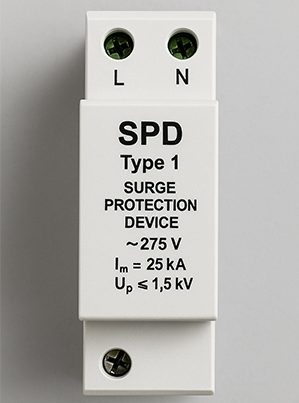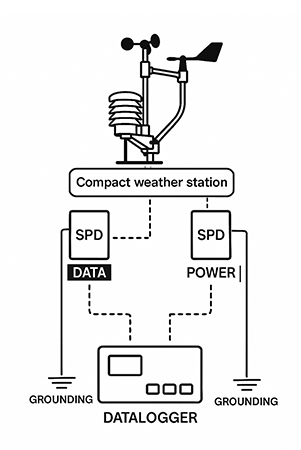Weather stations are a core part of modern solar plants. They deliver critical environmental data, such as irradiance, wind, temperature, and more. That helps teams track system performance and take action when needed. SEVEN Weather Stations are built for accuracy and rugged conditions, but like any electronic system, they are vulnerable to surges.
Surge Protection Devices (SPDs) are not just a good idea; they are a requirement for protecting your data, your equipment, and your bottom line.
Why Are Weather Stations at Risk?
SEVEN stations are usually installed on poles, rooftops, or structures near solar arrays—in other words, highly exposed locations. These setups are magnets for surge risks, such as:
- Lightning (direct or indirect strikes)
- Ground voltage rise during electrical faults
- Voltage buildup on long cable runs
- Switching transients from motors, inverters, or tracking systems
Since the station houses communication lines, power inputs, and multiple sensors, just one surge can create wide-ranging issues, taking out devices, interrupting SCADA communication, or degrading sensor accuracy.
What Happens Without SPD Protection?
Without surge protection in place, the consequences of a single overvoltage event can be severe:
- Permanent sensor damage (irradiance, wind, temperature, etc.)
- Modbus communication failures and device timeouts
- Data logger or power supply malfunction
- Potential fire risks from overloaded circuits
- Widespread data loss or system-wide SCADA failure
Even subtle damage can quietly affect measurement accuracy, leading to wrong assumptions about plant performance.
What Did a Real-World Failure in India Reveal?
At a large solar site in India, a single lightning storm caused extensive damage across the monitoring infrastructure. Due to poor grounding and the absence of SPDs, the surge burned out over 15 pyranometers, all SCADA communication devices, and several RS-485 lines in a matter of seconds.
The failure disrupted plant operations, causing data loss and delays in power output reporting. Technicians later discovered that surge protection had been skipped to cut initial costs. After retrofitting proper SPD systems and grounding networks, no similar issues were reported.
How Do SPDs Work and Where Should You Use Them?
Surge Protection Devices work by detecting high-voltage spikes and safely grounding them before they reach your equipment. They prevent energy from traveling through power or communication lines where it can cause damage.
Recommended Protection Zones
| Protected Line | SPD Type | Install Location |
| RS-485 Communication | RS-485 Line SPD | Inside the weather station cabinet |
| 24VDC or 230VAC Power | Type II or III SPD | At the power input to the station |
| Ethernet (if used) | RJ45 SPD | Near data logger or switch |
Always ensure proper grounding, and use SPD types rated for the system voltage and local environment, especially in PV installations, as recommended in IEC Standard.

What Are the Best Practices for SPD Use in SEVEN Systems?
1. Install SPDs
-
- SPD Type 1 must be used for AC power connections when available.
- SPD Type 2 or Type 3 must be used for 24V DC power connections.
- An appropriate SPD must be used to protect RS485 communication lines.

2. Ground Effectively
-
- Poor grounding makes even the best SPD useless.
- Keep resistance under 10 ohms and use a dedicated rod if necessary.
3. Protect Long Cable Runs
Anything longer than 10–15 meters (RS-485 or power) should have inline or panel-mounted SPDs to reduce risk.
4. Inspect and Replace When Needed
-
- The end user must regularly monitor the status of the installed SPDs, ensuring they are configured to send notifications to the monitoring system regarding their status.
- This will enable timely identification of any burned-out or non-functional SPDs, allowing corrective action to be taken accordingly.
- Failure to maintain the SPDs in proper working condition, including replacing damaged ones, will reopen the door to damages caused by electrical surges.
Frequently Asked Questions
Q: Are built-in SPDs in SEVEN sensors enough?
A: No. External SPDs are essential for serious surge events. Built-in protection offers only basic safety.
Q: How often should SPDs be checked or replaced?
A: Regularly monitor their status through your system. Replace any damaged or triggered SPDs immediately.
Q: Do SPDs protect communication lines as well?
A: Yes. RS-485 Line SPDs are specifically designed to prevent surges from damaging communication systems.
